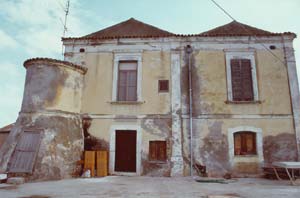![]() Fortifications
Fortifications
![]() Lowland fortifications
Lowland fortifications
Military
installations in the lowlands were less frequent. The models referred to were
the castrum and the quadriburgium, though they were freely
re-interpreted. The first fortifications were constructed by Guiscard and his
brother Roger (the first Norman castra are Scribla and later St. Mark
in Calabria). Built on the outside of towns or villages, their function was to
provide lodging for the troops assigned to policing the area. The term castellum
identified both a strong point outside a settlement and light installations
erected against the doors of a besieged castrum (after the city was
taken, they could be dismantled or transformed into a new strong point); or,
at a later date, a real citadel built within the castral burghs. The fortified
lowland settlements often played the role of military barracks for troops
entrusted with the military organisation of the territory, and later its
control. This model, often abandoned in Western Europe, was rediscovered (and
integrated with routes exposed to the defenders’ fire, avant-corps, moats
and embankments) after the campaigns overseas where it continued to be used.
Four-sided buildings with corner towers (square or circular in shape) were
almost always transformed in more recent periods; this is what happened to the
palace of Larino, which incorporated the older Norman castle. In Cercepiccola,
on the other hand, the castle is still perfectly recognisable. The same models
were not uncommonly reused for buildings (noblemen’s palaces) and
architectural complexes (often associated with agricultural activities) dating
back to the Aragonese or even more recent periods.
In most cases the original enceinte became the nucleus around which towns and
villages developed, especially in Lower Molise, such as in Portocannone or
S.Croce di Magliano (“Terra cinta di mura con due Porte”, Tria,
1744, divided into two parts, one assigned to the Christians and the other to
the Greeks).
|
|
Nuova Cliternia |
